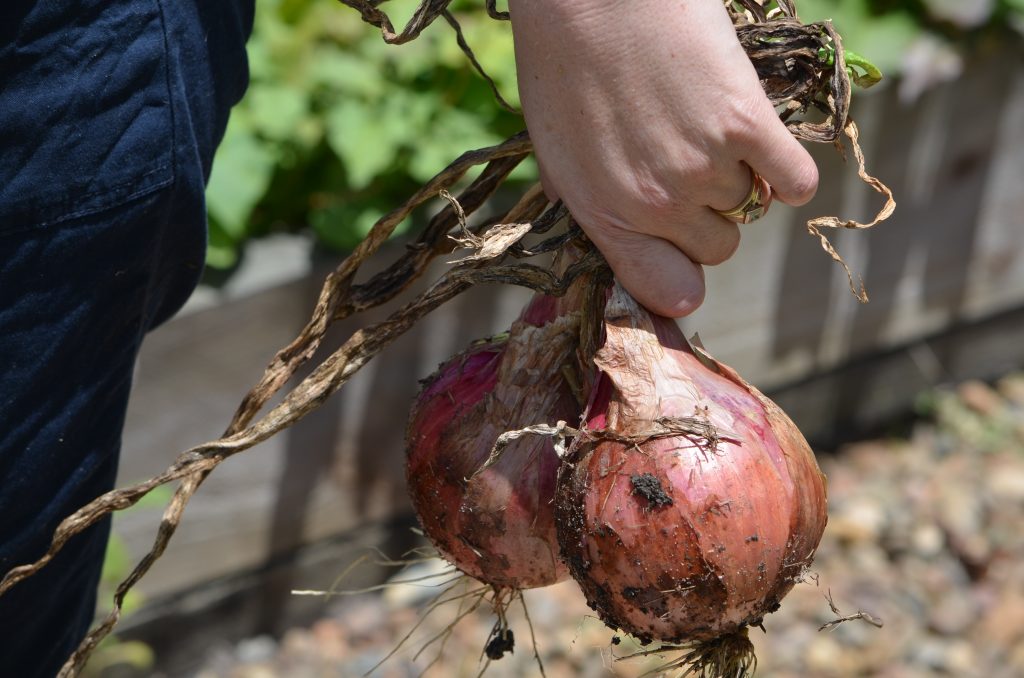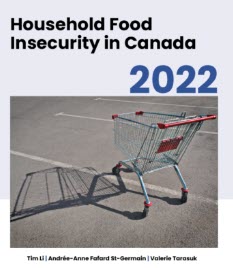Canadians have the right to food. “In 1976, the Canadian government ratified a part of the Universal Declaration of Human Rights…embedded in that declaration is our right to food”.1

Unfortunately, almost 4.5 million Canadians struggle with food insecurity and the problem continues to grow.2
As a definition,
“Food security exists when all people, at all times, have physical, social and economic access to sufficient, safe and nutritious food which meets their dietary needs and food preferences for an active and healthy life”.3
Simply put, food security exists when people have access to, and enough money to buy good food to feed their families in a healthy way every day.
Despite a great deal of study, food insecurity and what to do about it continues to be a problem in Canada. This problem is worsening due to the COVID-19 pandemic. Lowered incomes and layoffs have left families with even less money to spend on healthy food. Many Canadians are concerned about how the pandemic will impact food security in Canada.4
There is a direct correlation between food insecurity and poverty.
What is the Impact of Food Insecurity?
Food insecurity takes a serious toll on personal health and well-being that reaches far beyond hunger. It makes people feel stressed and sick, isolated from others and focus on work is difficult.5
There are three levels of household food insecurity:6
- Marginal food insecurity: Worried about running out of food, not enough money to eat balanced healthy foods
- Moderate food insecurity: Compromise in quality of foods eaten and/or quantity of food
- Severe food insecurity: Missed meals, reduced food intake among adults and/or children, and at the most extreme go the entire day without food.
To find out more about food insecurity and how it affects Canadians, read Beyond Hunger: The Hidden Impacts of Food Insecurity by Community Food Centres Canada.
Who is Impacted by Food Insecurity?
People of any age, race and gender can be at risk of food insecurity if they do not have sufficient access or income to buy healthy food. There are certain groups however, that are at greater risk. In households with children, and specifically single parent homes (especially single mothers), there are higher rates of food insecurity reported. Households where individuals identify as Indigenous or Black are also at higher risk of being food insecure. Other groups that are more vulnerable to being food insecure are those living with disabilities or chronic illness, and recent immigrants.7
- 14.4% of households in Manitoba are food insecure.8 Children, Indigenous people, racialized people, single parents, newcomers and people in northern communities all disproportionately experience food insecurity. This number is realistically even higher as this percentage does not include the homeless population or Indigenous people living on reserves.
- In 2017-18, about 1 in 5 children in Manitoba lived in households that reported being food insecure.9 This affects the physical and mental health of children, making it difficult for them to learn and grow in a healthy way.
- 1 in 8 Canadian households or more than 4.4 million people in Canada are food insecure.10
- More than 60% of Indigenous people living on reserves in Northern Manitoba are food insecure.11 Isolated Northern communities are negatively impacted by high prices and limited access to healthy foods. Grocery prices are significantly higher in communities where stores are limited, and food transportation costs are high.
Most households experiencing food insecurity are working households, but employed in jobs that are temporary, part-time or pay low wages. These jobs simply do not pay enough to provide income to cover the basic costs of living. Research has been done through the Canadian Centre for Policy Alternatives to identify how much income is required to cover basic living costs in Canada, known as a “living wage” calculation.
Learn more in the report: A Family Living Wage for Manitoba: 2024 update
The Four Pillars of Food Security
Food security is determined by four components or “pillars”. When any of these components or pillars are not met, it is considered food insecurity.12
Pillar #1 Food Availability: a reliable and consistent source of quality food. “Is there nutritious, quality food available to me every day?”
Pillar #2 Food Access: people have sufficient resources to produce and/or purchase food. “Can I afford to buy nutritious food? Is there food close to my home?”
Pillar #3 Food Utilization: people have sufficient food and cooking knowledge, and basic sanitary conditions to choose, prepare and distribute healthy food to their families. “Will this food nourish my family in sufficient ways?”
Pillar #4 Stability: a stable and sustained environment to access and use healthy foods. This means there is no risk to food supply due to economic, political, or environmental factors. “Will food be available to me consistently in the next few days, months and years?”
Why is Food Insecurity Happening?
People experience food insecurity because they lack the money needed to buy healthy food. The costs of housing, transportation, childcare, prescriptions and food are increasing every year. Single person households are becoming more common and people are trying to cover these costs on one income. Deep societal inequities, racism and the long lasting effects of colonialism have unfairly affected Indigenous people and minority groups.13 For some communities, access to healthy food is impossible, either due to a lack of reliable, affordable food sources or impractical travel distances required in order to buy it.
Food security is not a new problem. Food Matters Manitoba is a local not-for-profit organization that works with community groups, public policy makers and innovative thinkers to develop local, community-based strategies to address food insecurity. Read through their website for insightful research and strategies to address food security issues in the Province of Manitoba.

To learn more, read the current full 2022 report Household Food Insecurity in Canada from PROOF Food Insecurity Policy Research.
References
- Taylor, P. (2019, April). Food, a “sort of right”. FoodShare. Retrieved Nov 15, 2020 from https://medium.com/@FoodShareTO/food-a-sort-of-right-bb58805e20df
- Tarasuk V, Mitchell A. (2020) Household food insecurity in Canada, 2017-18. Toronto: Research to identify policy options to reduce food insecurity (PROOF). Retrieved Nov 13, 2020 from https://proof.utoronto.ca/food-insecurity/
- Food and Agriculture Organization of the United Nations. (2003). Food security: concepts and measurement. Retrieved Nov 17, 2020 from http://www.fao.org/3/y4671e/y4671e06.htm
- Majority of Canadians believe that hunger and food insecurity will worsen as a result of COVID-19. (2020). Food Banks Canada. Retrieved from https://foodbankscanada.ca/majority-of-canadians-believe-that-hunger-and-food-insecurity-will-worsen-as-a-result-of-covid-19/
- Community Food Centres Canada. (2020). Beyond Hunger: The hidden impacts of food insecurity in Canada. Retrieved July 30, 2025 (updated link) from https://cfccanada.ca/en/News/Publications/Reports/Beyond-Hunger-the-hidden-impacts-of-food-insecurit
- Tarasuk V, Mitchell A. (2020)
- Tarasuk V, Mitchell A. (2020)
- Food Matters Manitoba. (2020). Household Food Insecurity in Manitoba infographic. Retrieved Nov 13, 2020 from https://foodmattersmanitoba.ca/wp-content/uploads/2020/04/Food-Insecurity-Infographic-1-experience-2020-FINAL.pdf
- Tarasuk V, Mitchell A. (2020)
- Tarasuk V, Mitchell A. (2020)
- Food Secure Canada. Affordable Food in the North. Retrieved Nov 17, 2020 from https://foodsecurecanada.org/resources-news/news-media/we-want-affordable-food-north
- Parekh, L. (2020). The basics of food security (and how it’s tied to everything). World Vision. Retrieved November 14, 2020 from https://www.worldvision.ca/stories/food/the-basics-of-food-security#1
- Community Food Centres Canada. (2020)






